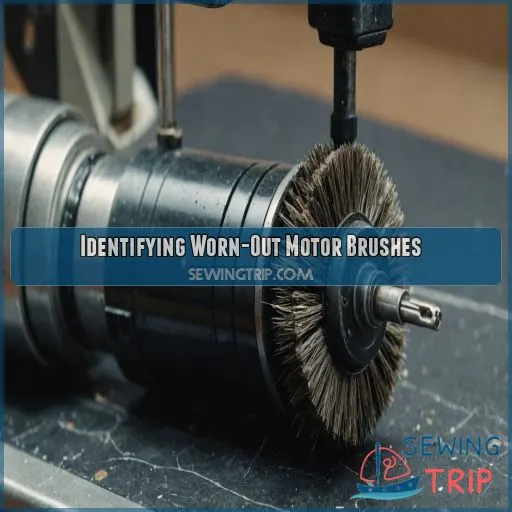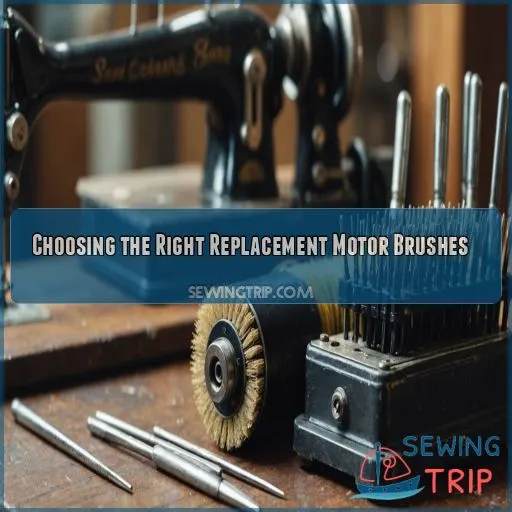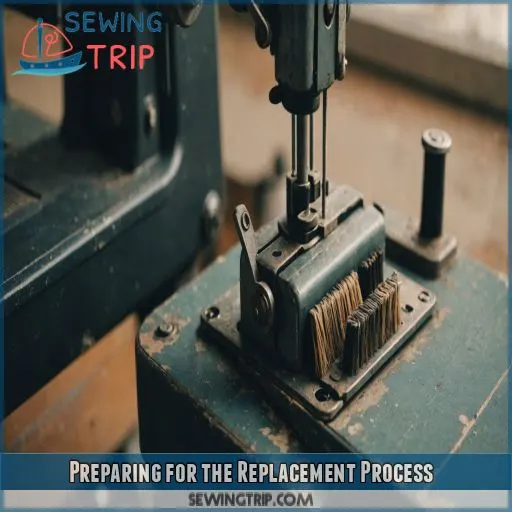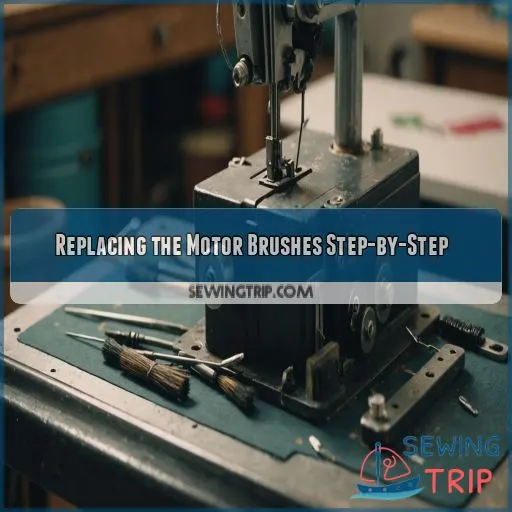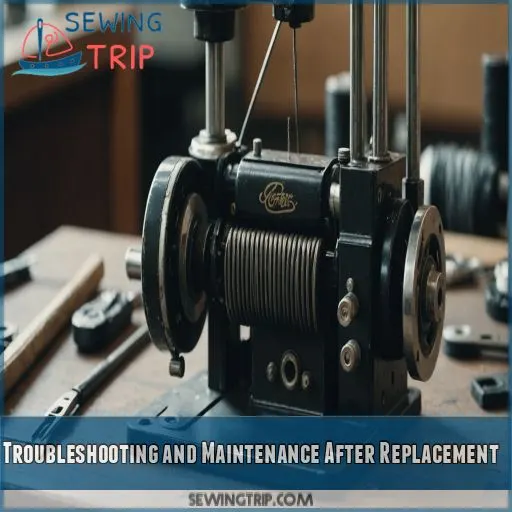This site is supported by our readers. We may earn a commission, at no cost to you, if you purchase through links.
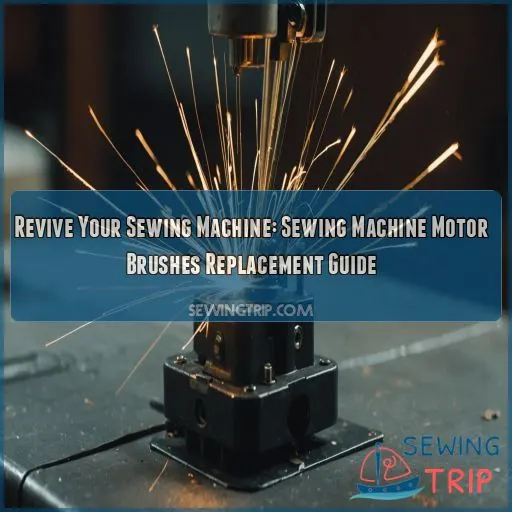
Don’t let worn-out brushes slow you down or damage your machine.
First, check for signs of wear like motor noise, reduced power, or sparks.
Inspect the brushes for uneven wear or excessive carbon dust buildup.
Choose the right replacement brushes, considering size, shape, length, and hardness.
Graphite, carbon, or hybrid – the material matters.
Gather your tools, take safety precautions, and follow a step-by-step guide to breathe new life into your trusty machine.
Get ready to sew like a pro again.
Table Of Contents
Key Takeaways
- You’ll know it’s time to replace your motor brushes when you notice excessive sparking, reduced performance, or worn-down brushes, so keep an eye out for these signs to avoid damaging your motor.
- Don’t risk damaging your motor by delaying replacement; swap out those worn-out brushes promptly to prevent overheating, stalling, or costly repairs down the line.
- Not all Sewing Machine motor brushes are created equal, so make sure to double-check your machine’s manual for compatibility before buying replacement brushes. You want a smooth stitch, not a headache.
- By replacing your sewing machine’s motor brushes, you’re not only saving your machine from premature retirement, but also saving yourself from the frustration of dealing with a sluggish motor. Take a deep breath, grab your tools, and get ready to breathe new life into your trusty sewing companion.
Identifying Worn-Out Motor Brushes
As you lovingly use your sewing machine, the motor brushes inside are hard at work, helping to bring your creative projects to life.
Over time, these brushes wear out, causing your machine to slow down or even stop working altogether.
But don’t worry, learning to identify worn-out motor brushes is the first step to reviving your trusty sewing companion.
Common Signs of Motor Brush Wear
You’re not alone if your trusty sewing machine has started acting up. Worn-out motor brushes might be the culprit. Here are some telltale signs:
- Motor Noise or strange sounds that make you wonder if it’s about to take off
- Reduced power or slow stitching that’s driving you crazy
- Sparks or brush dust flying everywhere – yikes, it’s time for a replacement!
How to Inspect Motor Brushes for Damage
Time to get up close and personal with your motor brushes! To inspect for damage, look for brush wear patterns, like uneven wear or excessive carbon dust buildup. Check the brush length, too – if it’s worn down, it’s time for a replacement. Also, test the brush spring tension and give the area a good visual once-over.
Understanding the Importance of Timely Replacement
- Reduces the risk of motor damage and costly repairs
- Prevents poor stitching and fabric damage
- Saves you from the hassle of sudden breakdowns
- Keeps you safe while sewing
- Helps maintain your machine’s overall health and performance
Choosing the Right Replacement Motor Brushes
Now that you’ve identified your worn-out motor brushes, it’s time to pick the perfect replacements to get your sewing machine humming again. When choosing new brushes, you’ll want to keep a few key things in mind, like material quality and compatibility, to make sure the swap is smooth and your machine runs happily for a long time.
Factors to Consider When Selecting Replacement Brushes
Choosing the right replacement motor brushes can be a puzzle, but don’t worry, we’ve got the pieces!
Consider the brush size, shape, and length to make sure it fits perfectly.
Think about the brush hardness, too – you want it to be gentle on your machine, but tough on performance.
Get these factors right, and your sewing machine will hum like new!
Understanding the Role of Motor Brush Material and Quality
When choosing motor brushes, material matters. You’ve got two main options: carbon and graphite. Here’s the lowdown:
- Carbon brushes: durable, but can be rough on the motor.
- Graphite brushes: softer, but wear down faster.
- Hybrid brushes: the best of both worlds, but pricier. Your choice will impact the brush wear rate, motor performance, and your wallet.
Preparing for the Replacement Process
Now that you’ve chosen the right replacement motor brushes, it’s time to get ready for the actual replacement process – gather your tools and materials, and take necessary safety precautions to avoid any electrical shocks or injuries. Before you start tinkering with your sewing machine’s motor, make sure you’ve got everything you need to do the job safely and efficiently.
Essential Tools and Materials Needed for the Job
You’re ready to give your sewing machine a new lease on life. To replace those worn-out motor brushes, you’ll need some trusty tools. Here’s a rundown of the essentials:
| Tool | Description | Why You Need It |
|---|---|---|
| Screwdriver | Flathead or Phillips | To access the motor |
| Pliers | Needle-nose | To grip small parts |
| Brush set | Replacement motor brushes | The star of the show! |
| Cleaning kit | Soft brush, cloth, and cleaning solution | To tidy up the area |
| Multimeter | For measuring voltage and current | To make sure everything’s working as it should |
Grab these tools, and you’ll be well on your way to sewing machine revival.
Safety Precautions to Take When Working With Electrical Components
Now that you’ve got your tools and materials, let’s talk safety.
When working with electrical components, it’s really important to avoid shock hazards.
Make sure you’re properly grounded, and consider investing in a circuit tester.
Wear safety equipment like gloves and safety glasses, and keep a fire extinguisher nearby.
Your safety is worth the extra precaution – don’t take electricity lightly!
Replacing the Motor Brushes Step-by-Step
Now that you’ve got your replacement motor brushes and your workspace is all set, it’s time to get your hands dirty and swap out those worn-out brushes. In this step-by-step guide, you’ll learn how to carefully remove the old brushes, give the area a good cleaning, and get your sewing machine humming like new again.
Removing the Old Motor Brushes and Cleaning the Area
Time to get your hands dirty! Using your motor brush removal tools, gently pull out the old brushes from the brush holder.
Next, inspect the holder for any debris and give it a good clean.
Don’t forget to wipe down the commutator, too – you want a squeaky-clean slate for your new brushes.
Make sure to check for any motor brush wear signs.
Reassembling the Sewing Machine and Testing the Motor
Now it’s time to put everything back together.
Reattach the motor housing, making sure all screws are snug.
Add a few drops of lubrication to the motor shaft.
Plug in your sewing machine and run a test seam. If it hums along smoothly, you’ve succeeded!
Check the needle alignment and run a sewing test to make sure everything’s working in harmony.
Troubleshooting and Maintenance After Replacement
Now that you’ve successfully replaced your sewing machine’s motor brushes, it’s time to troubleshoot and maintain them to make sure it runs smoothly. You’re probably excited to get back to sewing, but don’t rush just yet! Take a moment to:
- Check the motor performance: Run a few test stitches to make sure the machine is running smoothly and not producing any unusual vibrations.
- Keep it lubricated: Regularly oil the motor and other moving parts to prevent wear and tear.
- Monitor for issues: Keep an ear out for unusual noise levels or an eye out for signs of brush wear, which can cause sewing issues down the line.
Frequently Asked Questions (FAQs)
Can sewing machine motor brushes be replaced at home easily?
Think of motor brushes like your favorite sewing scissors – they need a little TLC to keep cutting smoothly! Replacing them at home is a breeze, just make sure to follow the manual and take necessary safety precautions .
How often should motor brushes be replaced in sewing machines?
You’ll know it’s time to replace your motor brushes when you notice excessive sparking, reduced performance, or worn-down brushes . Check them regularly, and swap them out every 1-3 years, depending on usage (Source).
What are the risks of not replacing motor brushes promptly?
You risk damaging your motor, causing it to overheat or stall, if you don’t replace worn-out brushes promptly. This can lead to costly repairs or even render your sewing machine useless .
Can faulty motor brushes damage other sewing machine parts?
If you don’t catch faulty motor brushes, they can wreak havoc on other sewing machine parts, causing costly repairs down the line. You might end up replacing the motor or even the entire machine .
Are all sewing machine motor brushes compatible and interchangeable universally?
Time to get brushed up on the facts! Not all sewing machine motor brushes are created equal, and compatibility is key. Double-check your machine’s manual to make sure you’re getting the right replacement brushes for a smooth stitch.
Conclusion
Breathing new life into your trusty sewing machine is a brush-stroke away!
By following this sewing machine motor brushes replacement guide, you’ve saved your machine from premature retirement and also saved yourself from the frustration of dealing with a sluggish motor.
With the right tools and a bit of know-how, you’ve successfully revived your sewing machine, and it’s now purring like new – thanks to your newfound expertise in sewing machine motor brushes replacement**!

